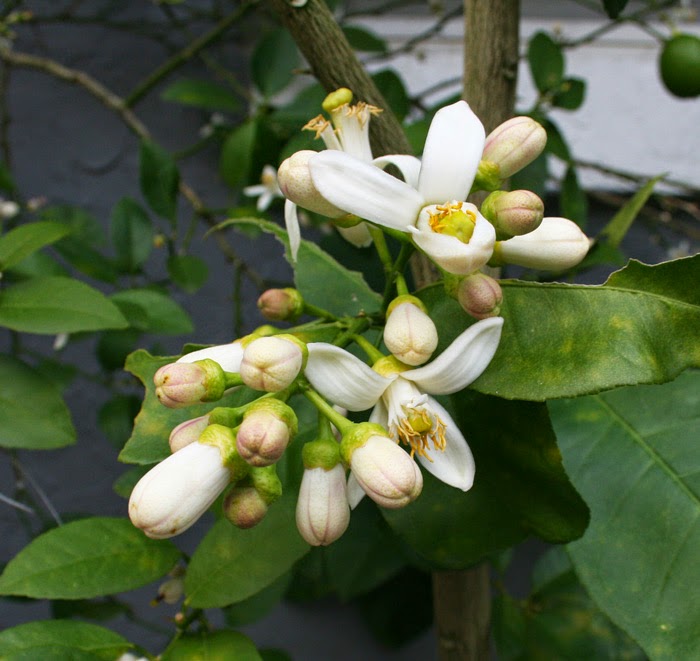New buds are starting to appear on many of my citrus trees. In the case of the Ponderosa lemon above, they popped a week ago.
Most of the citrus I have in my food forest and yard are at least three years old. Some of them, like the blood orange, have grown rapidly. Others haven’t done as well.
I’ve tried to be a good little organic gardener and feed them with chopped-down weeds, chicken manure, mulch and other goodies; however, I’m tired of waiting around for big trees.
I was at a local farm and hardware store recently when two men pulled up in a truck that had the logo of a local citrus grove on the side. I took the opportunity to ask them about greening and citrus fertilization.
On the greening front they told me their groves were doing fine so far, and on the fertilization front, I got some in-depth information. I actually took notes so I could share it here.
This is what the citrus farmers recommended to me.
How to Fertilize Citrus
Starting in February, apply 1 lb of citrus fertilizer (usually 6-4-6) for each inch of trunk diameter.
That means if you have a tree with a trunk that’s 4 inches across, you’d throw 4 lbs on the tree.
Continue feeding the tree the same amount every month until June then quit so you don’t encourage the tree to put on too much new growth that will be frozen off in fall.
Five applications, once a month, starting in February.
So… that’s how professional growers are fertilizing citrus around here.
I’ve read that you don’t want to apply fertilizer during the bloom or you may have the flowers drop off – but you are supposed to feed before the blooms appear.
Citrus need a range of nutrition so I’ll be supplementing my feeding with additional micronutrients. I’ve been looking for a way to feed citrus organically but that seems to be a tough row to hoe with citrus, at least if you want them to grow quickly.
I imagine that a good mix of cottonseed meal/blood meal, ashes, Epsom salts and bone meal might come close to being an organic citrus fertilizer, though. Compost tea would also be good for foliar feeding and warding off fungal and bacterial diseases.
Perhaps I’ll select a couple of trees and feed them different ways and see which one thrives.
Or maybe I’ll just go the easy route and hit all my citrus with chemical fertilizers, then repent AFTER the trees get big…
Shop at Amazon and support Florida Survival Gardening



13 comments
Looks like I will join you in throwing in the towel and "cheating" with chemical fertilizer. I just don't have enough compost ready for all the plants I want (yet).
Getting enough compost is always a problem. I'm working on a composting book right now that fixes some of that problem… but I can't reveal my super-secret methods until publication.
Well, he who is free of sin,cast the first stone….
I came across this you tube video on the origins of synthetic fertilizer. Perhaps it will allay your guilt a little.
https://www.youtube.com/watch?v=of2iHbruGL8
That was an excellent video – thank you. I worry more about the fillers in chemical fertilizer than the fertilizer itself… but since I'm not without sin, I won't cast the first stone… er… orange.
I know you haven't been to my place yet. I have 11 mature citrus trees- many varieties. Since my trees are mature and produce plenty of fruit, my major concern is health and pruning. I give them a light feeding of synthetic citrus fertilizer once a year, foliar sprays of neem oil and fish emulsion as often as I can (the timing is tricky) and mulch deeply with leaves. Some trees are thriving, some trees are not.
I know it's tempting but too much new growth is like ringing the dinner bell for pests. I bet your homemade non-synthetic fertilizer would get those trees growing too.
Yeah, maybe I should just make a big batches of manure/compost tea in barrels out in the food forest, then dump it on them when I think of it.
Or feed them straight ammonia so they grow 20' in one year.
Don't forget, the chemical fertilizers will kill the micro-life in your soil. Organic is always better for the soil food web.
You're right. I'm going to have to chase the evil stuff by adding compost/compost tea later.
What ratios of the blood meal/ashes/Epsom salt, and bone meal would you use if you were to be righteous?
Steve Solomon’s “Complete Organic Fertilizer” mix is really good: http://www.motherearthnews.com/organic-gardening/garden-fertilizer-zmaz06jjzraw.aspx
Otherwise, I’d probably give them each a cup of blood meal around the base at about the drip line, a cup of bone meal, plus a cup of Epsom salt. Add a cup of ashes, too, if you have them.
[…] Then I took notes, and posted them. […]
[…] a bit picky and the commercial guys feed them heavily with lots and lots of chemical fertilizer, as I outline in this post. Compost and compost tea work, but they take time. They also seem to like chop-and-drop, though […]
Comments are closed.